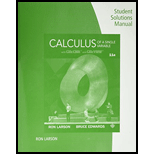
Determining Convergence or Divergence
In Exercises 9-30, determine the convergence or divergence of the series.
Want to see the full answer?
Check out a sample textbook solution
Chapter 9 Solutions
Student Solutions Manual for Larson/Edwards' Calculus of a Single Variable, 11th
- Finding the Sum of an Infinite Series In Exercises 17 and 18, find the sum of the infinite series. k=18110karrow_forward19. Σ n!(2x − 1)" -1arrow_forwardReal Analysis I must determine if the two series below are divergent, conditionally convergent or absolutely convergent. Further I must prove this. In other words, if I use one of the tests, like the comparison test, I must fully explain why this applies. a) 1-(1/1!)+(1/2!)-(1/3!) + . . . b) (1/2) -(2/3) +(3/4) -(4/5) + . . . Thank you.arrow_forward
- Find an infinite series (using the geometric form technique) that represents the fraction: 3 2-5x Give the interval of convergence for the power series you found in part(a)arrow_forwardCalculus 2 Question:arrow_forwardGeometric series In Section 8.3, we established that the geo- metric series Ert converges provided |r| < 1. Notice that if -1arrow_forwardAnalysis advance matharrow_forwardStudy the power series: - Using Limit Comparison Test show that this series converges when x = −2. - Justify if the series is absolutely convergent, conditionally convergent, or divergent at x = 12? - Determine the radius and interval of convergence of the power series.arrow_forwardDetermine if the series converges or divergesarrow_forward00 ()" Determine whether the alternating series 2 (- 1)" converges or diverges. n= 1 Choose the correct answer below and, if necessary, fill in the answer box to complete your choice. A. The series converges by the Alternating Series Test. B. The series does not satisfy the conditions of the Alternating Series Test but converges because it is a geometric series with r= C. The series does not satisfy the conditions of the Alternating Series Test but converges because it is a p-series with p = D. The series does not satisfy the conditions of the Alternating Series Test but diverges because it is a p-series with p = E. The series does not satisfy the conditions of the Alternating Series Test but diverges by the Root Test because the limit used does not exist.arrow_forwardInterpretation of the answer(1)arrow_forwardCalculus IIarrow_forwardarrow_back_iosSEE MORE QUESTIONSarrow_forward_ios

 College Algebra (MindTap Course List)AlgebraISBN:9781305652231Author:R. David Gustafson, Jeff HughesPublisher:Cengage LearningAlgebra & Trigonometry with Analytic GeometryAlgebraISBN:9781133382119Author:SwokowskiPublisher:Cengage
College Algebra (MindTap Course List)AlgebraISBN:9781305652231Author:R. David Gustafson, Jeff HughesPublisher:Cengage LearningAlgebra & Trigonometry with Analytic GeometryAlgebraISBN:9781133382119Author:SwokowskiPublisher:Cengage


